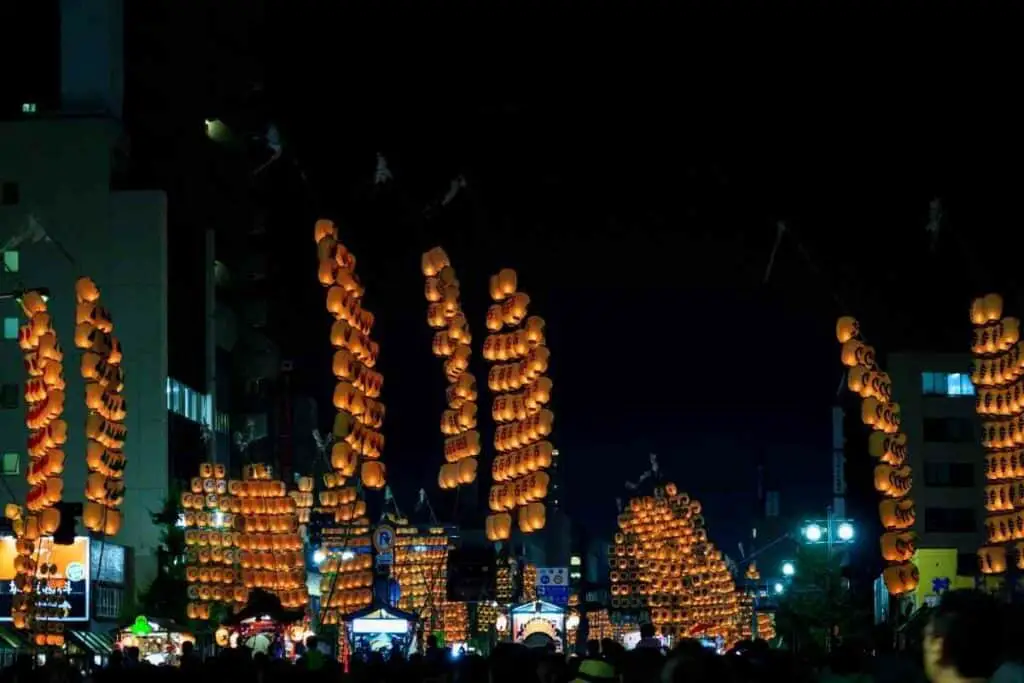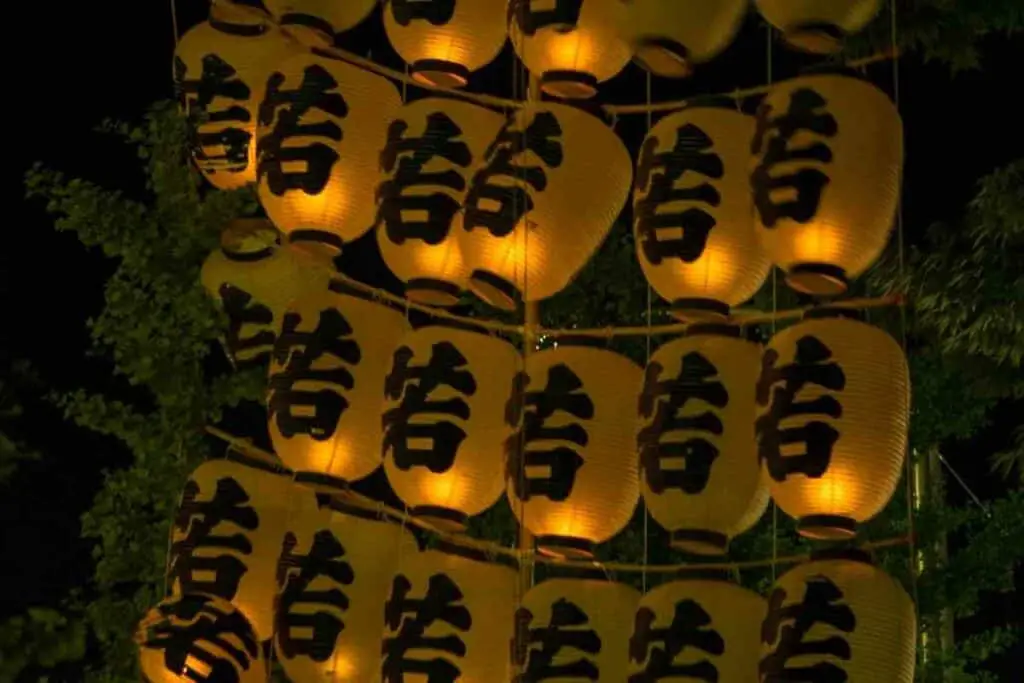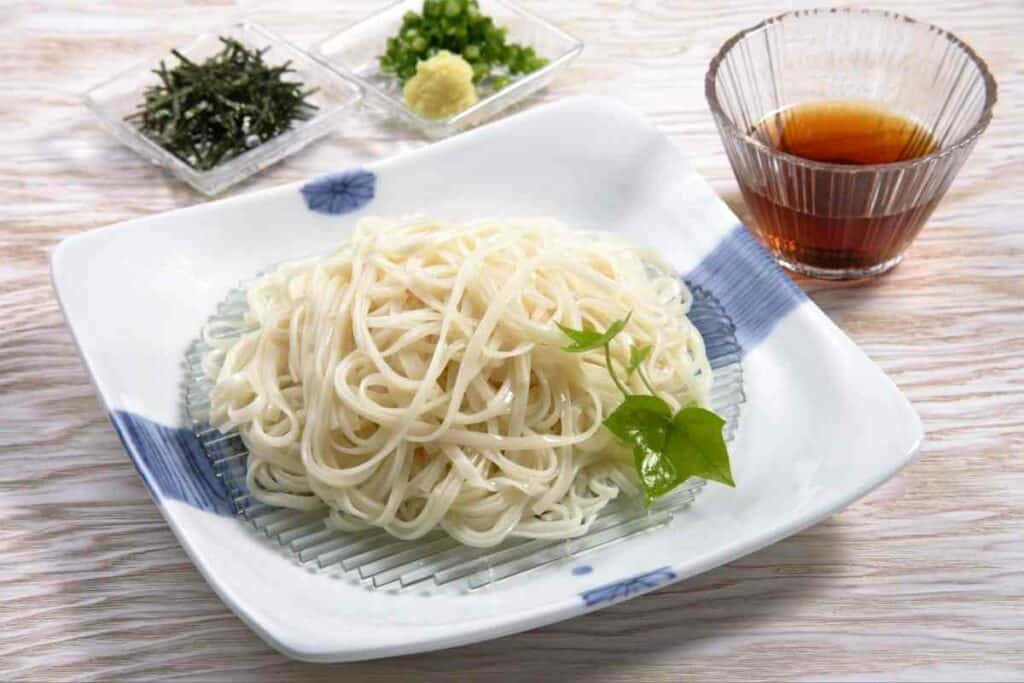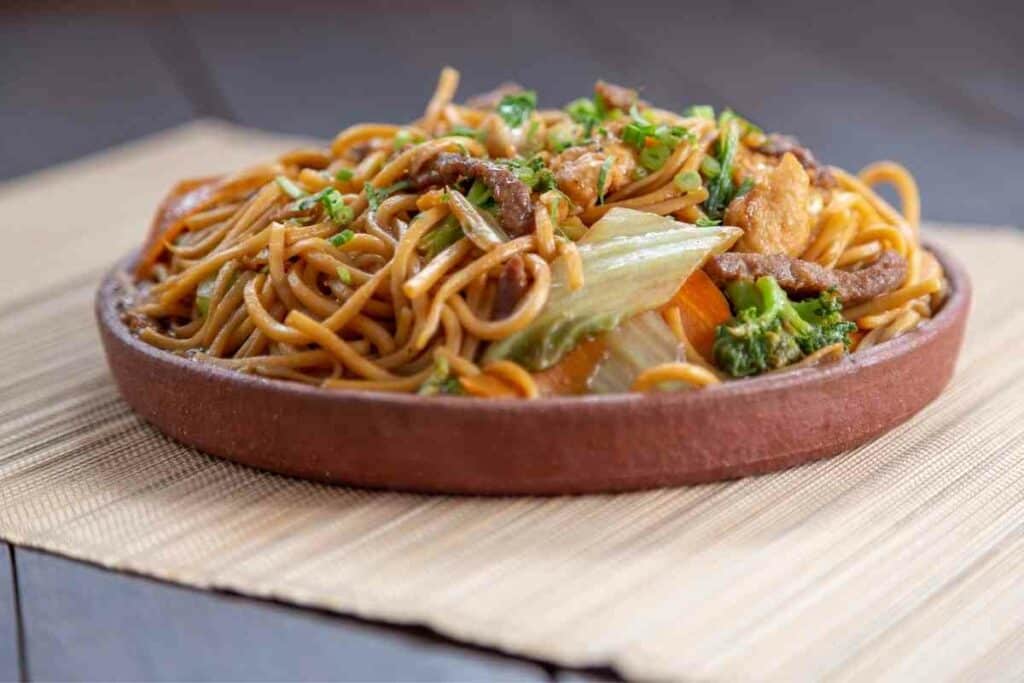If you’re traveling in Japan during August, you’ll definitely want to check out the Kanto Festival!
This annual festival celebrates the region of Kanto and its surrounding prefectures.

There’s always a lot going on during the festival, with fireworks shows and parades, but the main attraction is the lantern-carrying show.
If you’re looking for a fun and festive way to experience Japanese culture, be sure to check out the Kanto Festival!
Table of Contents
Origins of the Kanto Festival
The Kanto festival started in the late 1700s during the Edo period.
The festival started as Neburi Nagashi, a festival to cure summer illnesses and fatigue, and to pray for good harvests.

The people who attended the festival would write their dreams and wishes on strips of paper and use them to decorate silk trees and bamboo grasses.
They would carry their wishes through the city and then float them down the river in the hopes that their wishes would be granted.
By the mid-1800s, candles were being added to paper lanterns to create a soft light, but they needed to be carried somehow.
In 1881 – Tetsusaku Okubo had an idea to entertain the Emperor with a lantern performance where lanterns were attached to poles, calling it; you guessed it, the kanto.
Today, the Kanto Festival is held to banish bad spirits, and fatigue, and to bring in a good harvest of beans, Chinese millet, Foxtail millet, rice, and wheat.
The Kanto
So what is the kanto exactly? The kanto is the entire wooden piece that supports the lanterns.
They can be upwards of 40 feet tall and weigh 110 lbs.
Three types of bamboo poles make up the kanto.
1. Oyatake
The first part of the kanto is the Oyatake. This is the main stick that runs from the hand to the very top.
2. Yokotake
There are several Yokotakes on the kanto. These poles run perpendicular to the oyatake and they are the poles that the lanterns are attached to.
3. Tsugidake
The Tsugidake isn’t used for the parade, but as a fun show afterward. The Tsugidake is used to extend the Oyatake and make the entire kanto even taller.
What to Expect at the Kanto Festival
Let’s start by showing you what to expect instead of telling you.
This video shows the process of a team carrying the kanto once the lanterns are lit, and how they stand the kanto upright.
There are 46 lanterns on each kanto, and the parades will have over 10,000 lanterns being carried on kantos.
With this many flames in paper lanterns that are balanced on a 40-foot bamboo pole, this festival might sound a little risky.
There is definitely a risk and kantos have fallen onto trees or powerlines.
The risk adds to the excitement for some, and it is all a part of the Kanto festival experience.
The Costumes
For such a huge festival, it’s impressive that all of the participants wear the same thing.
The traditional outfit consists of a black kimono with white accents, white shorts, and a white band on the forehead.
In Japanese culture, wearing white is a sign of purity and it is supposed to bring good luck.
The color black is supposed to represent mourning, but for the festival, the color black is used to help scare away the bad spirits.
The Competition
The best part of the Kanto Festival is the kantos, but the highlight is the competition on the day before the parade.
This competition is a performance. In this video, you’ll see one person at a time balancing the kanto, with a Tsugidake attached to make it much taller and more challenging.
5 Ways to Carry the Kanto
During the competition, there are five ways to carry the kanto called myogi.
The competition is named after these techniques and is called Myogikai or the daytime Kanto.
These myogi must be practiced to perfection to receive high scores and do well in the competition.
- Hirate: A technique where the kanto is balanced in one hand raised above the competitor’s head.
- Koshi: The technique where a competitor balances the kanto on their hip. They keep a wide stance and their back bent to the side to allow the kanto to stand straight up without interference.
- Kata: Apparently the easiest technique, the kanto is balanced on the shoulder of the performer without being grabbed by the hand for any additional support.
- Hitai: The technique where the kanto is balanced on the forehead. When you see a competitor in this position, they have a very low, wide stance and they keep their arms spread out to help widen their center of gravity.
- Nagashi: This is a technique where one competitor supports the kanto while another competitor adds the Tsugidake. Masters of Myogikai don’t need any assistance and they can add the extension poles themselves.
Food Festival
If this wasn’t enough, there is also a Food Festival open at the same time as the Kanto Festival, where food is served on Japanese food trucks called Yatai.

There are two dishes you should try while you’re at the festival.
These two dishes are loved by locals, and they are easily the two most popular dishes served.
Inaniwa Udon
Inaniwa Udon is a type of udon that is made in the city of Inaniwa in Akita Prefecture.
The dough for the noodles is made with a high-quality wheat flour called “Koshihikari”. Koshihikari is a type of rice that is known for its sweetness and chewy texture.
The cooked noodles are served with vegetables and beef, with a tasty sauce that has a soy sauce base.
Yokote Yakisoba
Yokote yakisoba is a type of Japanese fried noodle that is popular in the Kanto region.

The dish is made with a type of wheat flour called “Japonica” that gives the noodles their yellow color.
These are thicker noodles, and they are served with a Japanese marinade called Fukijinzuke. It’s a pickling marinade that has a sweetness in addition to a sour taste.
Final Thoughts
The Kanto Festival is a Japanese festival that celebrates the traditional Kanto.
The lanterns are lit and carried through the streets in a parade, and there is a competition to see who can carry the kanto the best.
There is also a food festival at the same time with delicious Japanese food. If you’re ever in Japan during the Kanto Festival, be sure to check it out!
Posts You Might Like
- 12 Things Tourists Should NEVER Say in Japan
- Kissing Robot: Exploring the Popularity of the Chinese Kissing App
- Unlocking the Secret Dating Rituals Only Locals Know in Japan
- Samurai Armor: Ancient Protection for Japan’s Elite Warriors
- 10 Amazing Facts About Schools in Japan: Unique Traditions and Educational Practices
- Where can you see snow monkeys in Japan: Best locations and viewing tips









